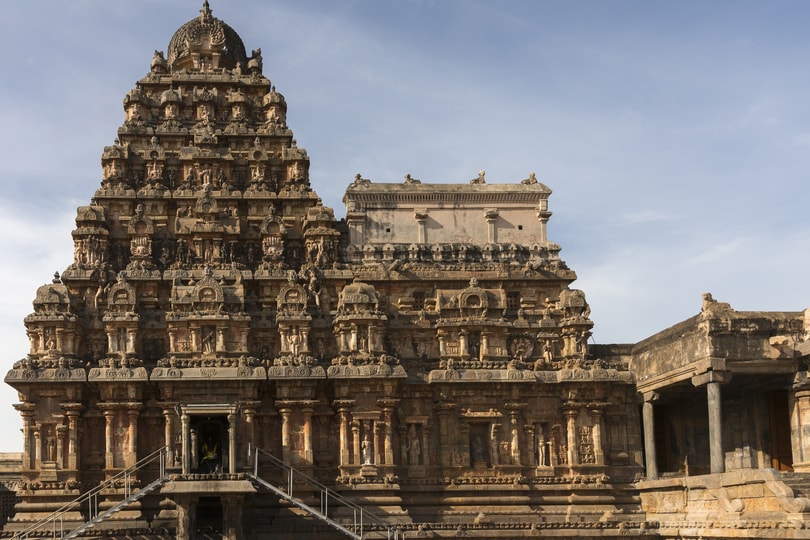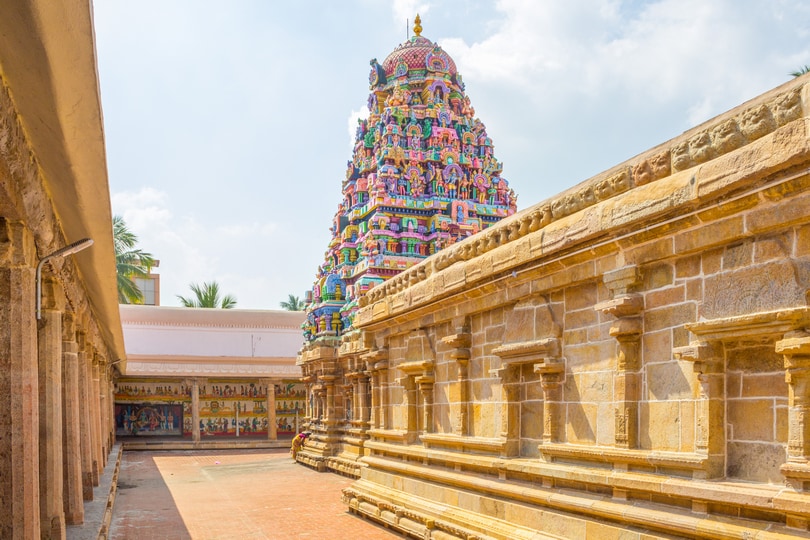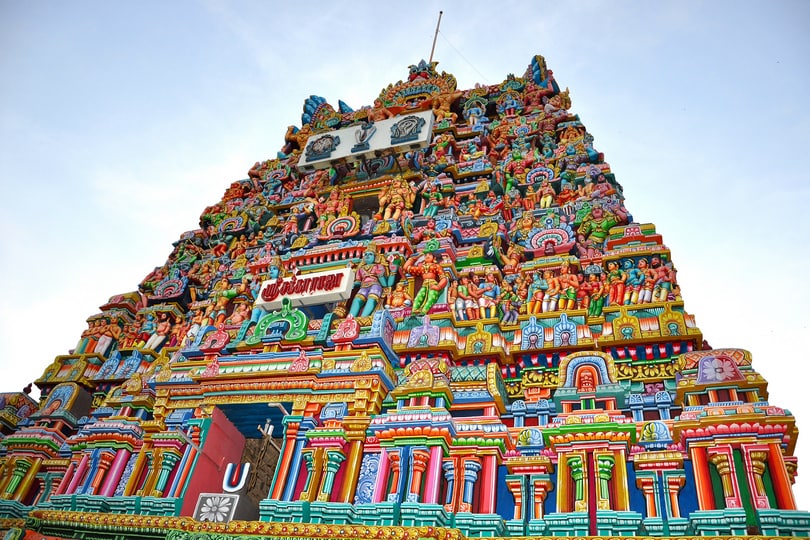The city of Thanjavur in Tamil Nadu is a renowned center of religion, art, and architecture of South India. Located in the Cauvery delta, Thanjavur is often called the ‘Rice bowl of Tamil Nadu’. Its economy is based on tourism, agriculture, and silk weaving. Classical Carnatic music was codified, and some Bharatnatyam styles were developed in Thanjavur, also famous for its Tanjore paintings. Thanjavur is home to the Great Living Chola temples – a UNESCO World Heritage site. The principal Chola temple, the Brihadeeswara temple, situated in the heart of the city, attracts tourists from the world over. Some of the other finest Thanjavur temples to visit are covered ahead.
Brihadishvara Temple is amongst the foremost religious sites in Thanjavur, known for its exemplary Dravidian architecture. The Brihadishvara, Gangaikonda, and Airavatesvara temples are together called the Great Living Chola Temples and declared a UNESCO World Heritage Site. Also called the Dhakshina Meru (Meru of the south), this temple was built by Raja Raja Chola I by 1010 AD. Brihadishvarain Tamil means the ‘Big Lord’, and this temple is often also called the ‘Big Temple’. Brihadishvara incorporates the Hindu traditions of Shaivism, Vaishnavism, and Shaktism. One of the largest South Indian temples, the complex has five sections – the sanctum and Vimana (tower), the Nandi hall, the assembly hall (mukhamandapam), the gathering hall (mahamandapam), and the prakara (pavilion). The Shiva lingam in the sanctum sanctorum is one of India’s largest such monolithic sculptures. The presiding deity is worshipped as Karuvarai, meaning ‘womb chamber’. Its 16-storeyed granite vimana is a landmark for the city, and one of the largest vimana in South India. Some significant and beautiful shrines are of Parvati, Murugan, Nandi, Ganesh, Dakshinamurti, Subrahmanyar, Sabhapati, Varahi, and Chandeshvara. The temple is also noted for being the site where the brass Nataraja idol was first commissioned in the 11th century. The temple walls, floors, and ceilings are adorned with magnificent sculptures, ornate inspirations, and striking murals.
Timings: 6 am to 12:30pm, 4 pm to 8:30pm
This grand temple was built under Rajendra Chola I in 1035 AD as part of his new capital at Gangaikonda. The Chola king instructed the defeated kings to send pots filled with water from river Ganga, which was poured into Cholagangam, the temple’s Kunda (water tank). The name Gangaikonda is thus made of Ganga and kunda. This temple shares the same design and name as the older Brihadeeswarar temple of Thanjavur, but it is smaller in size and more refined. Both the Brihadeeswarar temples are the largest Shiva temples of South India. This Dravidian style temple is a UNESCO World Heritage Site. Surrounded by walls and a cascading garden, a massive Nandi bull sits outside facing the main temple sanctum. The sanctum houses the presiding deity, Brihadeeswarar in Shiva lingam form. The temple has five shrines, and the navagrahas (nine planets) are carved out of a single stone. The vimana is deliberately kept shorter than the older Brihadeeswarar temple – as a mark of respect to his father’s work. The sri-vimanais nine-storied features symmetrical artwork, which is repeated in all the levels. The shrinking pattern of the artwork is rhythmic but not linear, lending the vimanaan unusual parabolic form. The neck protrudes in four cardinal directions, capped with kirtimukhas (face), and Nandi bulls seated on each corner. Next, a kalasa (cupola) sits on an open lotus, and above the kalasa, another lotus bud opens into the sky.
Timings: 8 am to 9 pm

This 12thcentury temple was built by Rajaraja Chola II. A UNESCO World Heritage site, Airavateswara is smaller but more exquisite amongst the three Great Living Chola temples. Dedicated to Shiva, the temple also features traditions of Vaishnavism and Shaktism. At some point this temple was destroyed. Its original inner courtyard survives today, along with the Nandi mandapa and stambha (pillar) standing tall outside it. The fine Dravidian architecture exhibited at Airavateswara is called Karakkoil – a style inspired by temple chariots used during festival processions. Morning and evening sun dials form the chariot wheels. The reliefs along with the main temple bear carvings that depict stories of the 63 Bhakti saints. Some stunning sculptures include those of the river goddesses, and the 108 Devara Othuvars- musicians who sang at the royal court. The temple is named after Airavata, Lord Indra’s elephant. As per legend, Airavata’s clean, white skin was restored after it bathed in the temple tank. This legend is even carved on a stone in sanctum. The temple features unusual steps, the Bali Pitham, with intricate carvings and baluster which produce musical notes when waked upon, and are thus called ‘singing steps’.
Timings: 6 am to 12 pm, 4 pm to 9 pm

This 16thcentury temple dedicated to Lord Rama was built by Nayakkar kings. This thanjavur temple features a characteristic Nayak style of temple architecture. A three-tiered gopuram is enclosed within walls. Carved out of a single stone, each of the 64 exquisite pillars depict various scenes from the epic Ramayana. Rama is seated with his consort Sita in the sanctum sanctorum. Standing alongside are his brothers – Lakshmana, Bharatha, and Chatruguna, while Hanuman is worshipping. The outer precincts are striking for the Chitra Ramayana – a pictorial depiction of Ramayana. This prominent temple of Kumbakonam also celebrates the prestigious Mahamaham festival.
Timings: 6 am to 12 pm, 4 pm to 9 pm
Kampaheswarar temple is dedicated to Lord Shiva who rid a king from quaking (kampa). The vimana of this temple is very high – uncharacteristic of its Dravidian architectural style. Inscriptions on the temple wall suggest that it was built by a 12th century Chola king. A Shiva lingam is the presiding deity of the temple. The temple also houses a shrine of Lord Sarabeswarar, a half-lion half-beast deity. His four-armed and three-legged sculpture is shown with Narasimha struggling under his feet. One of the earliest representations of the mythical creature of Yali in Chola art is found at this temple.
Timings: 6 am to 11 am, 5 pm to 8 pm
One of the Saptha Vigraha Moorthi (seven prime consorts) in all Shiva temples is located at the Swetha Vinayagar temple as Vinayagar, a form of Lord Ganesha. Built under the Chola dynasty, the temple is renowned for its white coloured Ganesh shrine made of sea foam. A stone window pane with fine latticework, palahani, is also housed in the temple. Kapardiswarar, a form of Lord Shiva and his consort Brihannayaki, are the presiding deities. The temple features an image of sage Herandar, who is credited for bringing the river Cauveri to Thiruvalanchuzhi. The presence of Buddhist images in the temple indicates an influence of Buddhism.
Timings: 6 am to 12 pm, 4 pm to 8 pm
Swamimalai temple is believed to have existed since the 2nd century BC. The temple is an arupadaiveedu, one of the six holy shrines of Lord Murugan. As per legend, Murugan praised the meaning of Pranava Mantra (Aum) to his father Lord Shiva at this site, and thus earned the name Swaminathaswamy. Adorned with a diamond lance and golden crowns and armours, the shrine of Murugan is located atop a hillock, while the shrine of his parents, Shiva and Parvati, are located downhill. The beautiful Thanjavur temple is only one of the two places which maintain the iconography of exhibiting elephant as the original mount of Murugan.
Timings: 6 am to 12 pm, 4 pm to 10 pm
Aiyarappar temple is considered a kailasam – one of the six temples on the banks of river Cauvery which are equally revered as the Kashi Vishwanath temple. It is thus referred to as Dakshina Kailasam – Shiva’s southern abode. The one-roomed home of music composer Thyagaraja situated next to the temple, and his shrine on the river banks are major tourist attractions. Hymns of Thevaram are incarnated in the temple. Aiyarappar is considered the foremost amongst the seven Saptha Stanam temples, and it is also included as a Paadal Petra Sthalam. The presiding deity is named after the five rivers of Tiruvaiyaru. The temple complex contains five water bodies and a Homa Kund, started by sage Adi Sankara.
Timings: 6 am to 11 pm, 4 pm to 8:30 pm
This 9th century temple is often credited as one of the largest temples in India. A Shiva lingam is worshiped in the form of Moolanathar, and his consort Parvati as Kondi. The presiding deity is the sacred 7th century Saiva text Tevaram – recognized as a Paadal Petra Sthalam. Built in Dravidian architectural style, the temple has innumerable shrines and halls. The main shrines are of Vanmikinathar (Shiva) and Thyagaraja. The temple was an important center for Jainism and the Golaki matha during the 13th and 14th century. It owns the largest chariot in Tamil Nadu and is known for ajapathanam – a dance by the deity performed without music. Some unique features of this temple are, a standing Nandi bull facing the presiding deity, the gigantic Kamalalayam tank, and sundials to observe stars. The complex also features nine planetary deities as navagrahas, and pathiri (trumpet flower) as the temple tree.
Timings: 5 am to 12 pm, 4 pm to 9 pm

This temple is dedicated to Lord Vishnu in the form of Chakrapani, who symbolizes the chakra – the discus, most powerful weapon of Vishnu. The shrines are enclosed within granite walls, and a five-tiered gopuram is supported by exquisite pillars. The presiding deity sits on an elevated structure in the sanctum sanctorum. The eight-armed Chakrapani holds a weapon in each hand, and sports a third eye on his forehead. A five-faced (panchamukha) Hanuman is featured in the outer precincts. Parallel to the shrine, is the famous Chakra Padithurai ghat. The offerings to the deity (neivethanam) are consonant with the amount of smoke exuded by the burning corpses at the ghat, symbolizing the chakra (cycle) of life and death. Another peculiarity is the practice of vilvaarchana, a ritual generally performed in Shiva temples. This temple is the venue for Mahamaham festival which is celebrated every 12 years in Kumbakonam.
Timings: 7 am to 12 pm, 4 pm to 8 pm
Thanjai Mamani Koil or Neelamega Perumal refers to a group of three temples on the banks of river Vennaaru. The temple is dedicated to Vishnu, who is worshipped as Veera Narsimhar, the presiding deity. His idol is beautifully sculpted with his hand placed on an elephant. The site of temple is where saint Parasarar mediated upon Lord Vishnu. This temple is regarded a divyadesam – one amongst the 108 Vishnu temples revered by the 12alwars (poet saints). Unlike other divyadesams where only one shrine is mentioned, all the shrines of Neelamega Perumal are referred in all the paasurams (poems) written by the alwars. All of the Thirumangai Alvar, Nammalvar and Bhoothathalvar paasurams of Thanjai respectively refer to the three temples of Maamanikoil, Manikunram and Thanjiyali Nagar.
Timings: 7 am to 12 pm, 5 pm to 8:30 pm
Nearby Thanajavur lies the ‘temple town’ of Kumbakonam. Amongst the navgraha (nine planets) thanjavur temples, some famous ones are – the Alangudi temple for Jupiter, Kailasanthar for Moon, Saneeswaran for Saturn, Naganathaswamy for Ketu, Naganathar for Rahu, and Sukran for Venus. Thanjavur also features a few of the Paadal Petra Sthalams–275 Shiva temples revered by the Nayanars clan. The Thanjavur Art Gallery, Sangeet Mahal, Poondi Matha, Maratha Palace, Saraswathi Mahal Library, Sivaganga Par, and Schwartz Church are some popular attractions in Thanjavur.

Please go back to portrait mode for the best experience